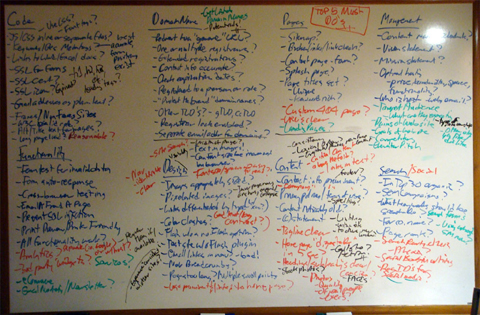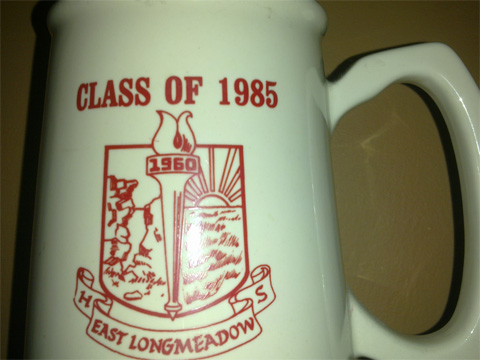How I Took An Idea And Made It A Reality
 With all the ideas and events swirling through the Windy City during the recent Chicago Ideas Week, one of those thoughts was what I would like to share here, how I took an idea I had and made it a reality. Though this story took place a few years back, it is still very vivid in my mind.
With all the ideas and events swirling through the Windy City during the recent Chicago Ideas Week, one of those thoughts was what I would like to share here, how I took an idea I had and made it a reality. Though this story took place a few years back, it is still very vivid in my mind.
My idea was to create a piece of marketing collateral for my Web consulting business. In this case, I could leave it would a prospect client, allow it to be downloaded from the Web and simply put it out there in printed format, the last 2 cases would be for anyone who wanted it. Depending on where the prospect was, it could server anywhere from a calling card, functional tool or a call to action to contact me.
Origin of the Idea
In my Web consulting business there were 2 categories for prospects – those who did not have a Web site and those who had one and were looking to possibly redesign and/or rebuild it. Where there were many common elements between the 2 for the sales process, when talking with someone who already had a Web site there was always a level of ambiguity to what exactly they needed or wanted to do and to what extent.
To try to streamline this process in a non-intimidating way, I thought of a form of checklist, where someone could read off the list to see if they had any or all of the items incorporated into their Web site, or at least to pose the questions in the event they didn’t know. In my mind’s eye I had a partial vision of the checklist. I saw it as paper-based, as likely someone would read a question from it then look on their Web site on their computer’s monitor for the answer. I wasn’t sure if there should be a score of some form or not. I was very sure I did not want it to be too technical and I did want it targeted to the business owner.
As for what would be in the checklist I had some ideas, but this was something I wanted to put time into over a period of time, then organize them into the checklist.
Like Rodney Dangerfield’s Joke Bag
The process of collecting the items for the checklist had me recalling a story I once heard about the late-great comedian Rodney Dangerfield. Before he got into comedy, he was a salesman and would write jokes on pieces of paper and put them into a duffle bag. When the bag was full, he had the material he would use on stage.
My approach was similar, yet different, as my duffle bag was digital – consisting of folders on my hard drive and in my email program. The ideas I captured varied from text files to links to other Web sites to email newsletters, where some of these items were direct ideas and others either categories or thoughts. I let this collection come together over a period time (exactly how long I do not remember). Then one day I decided to start the process to build the checklist.
Molding the Ideas into the Finished Product
As the collection process had elapsed some time and I didn’t remember everything I had put together, I decided I would go through them, one-by-one and begin curating a list. This was facilitated with the help of my whiteboard. As I read an item, I checked if it I already had it on the board, and if not I added it in some semblance of order. When all was done, this is what my whiteboard looked like:

At first glance, it is a mess. But it was the first pass at the organization of the items and ideas. Needless to say it was worthy of a picture!
From here, I started typing up the ideas, and in some cases I would combine like or similar ones. As I typed them up, I erased them from the whiteboard. At the end of this process hundreds of files and emails were in a clean list, just as clean as the whiteboard now was.
The next step was to boil the list down to a manageable, 1-page list, with the top, most important items on it. This was done over several days, as I would look at the list for a while, then revisit it later with a fresh brain. In the end, I finalized a list of 34 items and broke them down into 3 categories – business, content and design. I also came up with some copy to describe the checklist to put on the reverse side of it. At this point I felt really good about the checklist. Well, except for the name of it.
(Queen’s) Landing on the Right Name

The original name I had for the check was, and get ready for it:
The Web Site Redesign Self-Assessment Checklist
Yes, it sucked. Here I spent all of this time and produced what I felt was a quality product, yet the name would surely be a turn-off, and in some cases scare off people. I decided to put the completed checklist aside as I needed some more quality time to get the name right.
On a Friday evening after work, I went for a walk along Lake Michigan. Armed with a good cigar, I just needed to clear my head after a busy week and stretch my legs. As I was strolling by Belmont Harbor, the topic of the checklist name came front in center in my head. I recall shaking said head and saying to myself, “why don’t I have a better title for this” and the gears in my head started to crank.
As I headed south along the lakefront path, I started decomposing the goal of the checklist. The thought process went something like, “it’s where your Web site is now… it’s a point in time… it’s the current state your Web site is in… wait, that’s it – it’s the State of your Web Site!”
I stopped where I was, at a place along the lake called Queen’s Landing and called my office line and left myself a voicemail message on the name so I wouldn’t forget my inspiration. When I got back from my walk I edited the Word document with the name and then registered the domain name for it.
The State of the State Then and Now
Upon completing the checklist I setup a download page for it and promoted it here on The Hot Iron and elsewhere. I printed copies of it to give people in person and to bring to events as a leave-behind. Although the list never was mentioned on the cover of the Wall Street Journal, it would get a handful of downloads each week and I got good feedback on it from prospect clients and current clients as well.
Now almost 3 years after I created the checklist, it needs to be updated a bit, which would come probably after a new brainstorming session on it. That being said, there are many core concepts on the checklist that are still very relevant today as-is.
See for yourself – download a copy of The State of Your Web Site here right now!
Ideas, Visited
Ideas are just that, intangible thoughts. Without any action, they will remain in that state, floating out there. I know, as The Hot Iron is full of ideas I have had over the years. Where I have acted on many of ideas over the years, I am very proud of the creative process I have just shared here.
Your thoughts – and ideas – on the checklist and the process which led to it are welcome in the comments.
Editor's Note: This post was updated to correct and replace broken links.
This is from The Hot Iron, a journal on business and technology by Mike Maddaloni.
Did you enjoy this? Subscribe to The Hot Iron by RSS/XML feed or Read by Email
Build • Business • Strategize • Technology • The State of Your Web Site • Thrive • Web Design • Web Development • (0) Comments • PermalinkMeeting People Is Believing In People In The Workforce
In this hyper-connected, telecommuting, Internet-enabled, outsourced, offshored, cloud, remote-working world, it is not uncommon to never meet people you work with. In some companies it has become almost the norm, and it is only rare exceptions where people see even a live video stream of someone, let alone meet them in the real world. For many people, this is ok.
As you may have guessed from the intonation of the previous paragraph, I am not one of those people. If anything, I make the extra effort to go out of my way to meet people whenever possible. It’s something I learned early on in my career, and it has worked not only to my advantage, but projects I have worked on over the years as well.
To Utah Or Bust
Back in the late 90’s I was consulting on what I would call the most unique, fun, learning and dynamic project of my career. Put it like this – I had over an hour’s drive each way to work and it never even phased me! Where I could write many posts on that project in itself, the project was my first end-to-end Web and service project, and eventually I was the manager of the entire technical environment.
But as the saying goes, all good things must come to an end, and in this case, the client was closing their business unit I was working at and my project was sold to another company. That company had its own development and technical resources, and my job was to transition everything from knowledge to software to hardware to the new company. To add to the logistics, the new company was outside of Salt Lake City, Utah, where I and the project was south of Boston, over 2,000 miles away.
After the client manager informed me of the changes in the project he paused and asked me what was the first thing I needed to do for the move.
I said, “I need to book a flight to Utah.”
When the client manager pressed me for details, my response was straightforward and convincing. We needed to first ship the software and data to the new company, all over the Internet, and set it up on temporary servers. Then once done we’d literally pack and ship the servers to them, then move the data back onto the old servers. Not only had none of us – the current client, new company, or me – done something like this before, but it was 1997 and not many had done something like this period.
Therefore meeting the staff at the new company that would be on the receiving end of this was crucial. It was my job to ensure that the move went smoothly and we were up and running right away. I had to know what – and who – was on the other end and that they shared my commitment to the project, were capable of working on it, and if there were issues, they shared my dedication to resolving them.
Meeting and Believing
So I booked a flight from Boston to Salt Lake City and spent a week south of the city with the team. Following our initial meet and greet, we got down to business, including touring their facilities, reviewing the project plan and made some changes based on their feedback, and discussed the transition and longer term for the project, namely as I would not be a part of it any longer. We also had lunch together and a couple of dinners and got to know each other better, along with sharing stories of past tech projects. As my flight took off for my return trip to Boston, I felt very good and confident the project would be extremely successful.
When I returned to the client the following week, the client manager asked me how it went. I first showed him a list of everybody’s name, email address, and work, home, mobile and pager numbers. Needless to say he was pleased as I went into further details on the trip and overall plan.
In the end, the transition went off smoothly. We had a few issues, such as the data transfer taking longer than anticipated, but in the end everything was up and running over the course of a weekend. The following week there was an issue with one of the temporary servers on the other end, but I worked with their team and reported back the status to the client’s client to ensure everything was under control, and soon after I reported the good news we were back up and running.
Following the transition of the server environment came the transfer of the software development, and my role on the project came to an end. Where it was bittersweet for me, I was more concerned for the people who worked for the client who were losing their jobs. Another project for me was followed by a job change and onto even more adventures.
To this day I strive to meet the people I work with in person. What worked well in 1997 seems even more important sixteen years later.
This is from The Hot Iron, a journal on business and technology by Mike Maddaloni.
Did you enjoy this? Subscribe to The Hot Iron by RSS/XML feed or Read by Email.
Business • Strategize • Technology • Web Development • (0) Comments • Permalink
Why RSS Still Matters Despite What Google Does #VIVARSS
In past posts here on The Hot Iron I have talked about Real Simple Syndication or RSS. Most recently in a post titled “iGoogle Shutdown And The Demise Of The Personal Home Page” I talked about how subscribing to various RSS feeds is replacing my iGoogle home page.

Since that post a major announcement was made this week that Google is dumping its free offering of an RSS feed aggregator, Google Reader, as announced on its official blog and subsequent post on its Google Reader blog. The service will be ending on July 1, 2013, just short of 4 months away. What is interesting is that Google gave a 16-month notice when it announced it was shuttering the also-free iGoogle service. Observing online sentiment over the announcement, there was more emotion over this than the news of the day before of the selection of a new pope!
So why the frustration? For me personally, as I switched to Fever last year, losing the service won’t impact my personal consumption of information via RSS feeds. Before I get into it I’ll offer up an explanation of what RSS is – if you are already in the know you can skip it or go ahead and read it to critique my approach to defining it.
So What Is RSS?
For those who are reading this please note I will not try to get too technical, rather explain the process. RSS is a method of informing of new content published, It is achieved by posting some or all of that content and related meta data, links, inages, etc. to a data file. This data file has a particular structure as it is formatted in the XML language (I won’t get into XML here, but if you must follow this link to learn about XML). That data file is placed on a Web server for anyone to access or subscribe to with a public Web URL (the file can also be private too, but I digress). Whenever content is added or any is changed or deleted, the publisher of the content can update the RSS file. As this file can change frequently, it is referred to as an RSS feed, as in feeding new content to the consumer of it.
The RSS feed in itself is not the only place where the power of RSS lies. Software, called an RSS feed aggregator or an RSS reader processes these RSS feeds that are subscribed to and organizes them to present the content to the consumer. There are a variety of RSS feed readers out there, from installed software, mobile apps, Web services (like Google Reader), as well as Web browsers and email clients. The reader also keeps track of what has been read, so that when the RSS feed is updated, it will show new vs. old content, among other features as linking to the source content on its Web site and social media and email sharing functionality. This concludes this RSS overview – let me know if it is clearer to you, or clear as mud.
Now Back To Our Story
Of all of the RSS readers out there, one of the most popular has been Google Reader, It’s power has been in its simplicity and robust formatting and sharing features, plus the fact it was from Google and integrated well into your Google account and that it was a free Web service. So when it was announced that what may be the most widely used RSS reader is going away in a few months, there was much shock and dismay, not only from people who use Google Reader to consume content but from content publishers as well, as an important channel may go away if those consumers of content do not find an alternative to Google Reader.
So why would content publishers be upset? They are still publishing the content so people can still seek it out to read it. First, I’ll give a perspective to who all of these publishers are. When one thinks of RSS feeds, they often only think of blogs and news. Most all blogging software includes out-of-the-box the ability to generate an RSS feed or multiple feeds, and typically you have to make an effort to turn this off. Many believe – including myself – that RSS feeds plus the ease of publishing have led to the popularity and success of blogs. News Web sites are a perfect match for RSS as they are constantly publishing content. This is why most sites not only offer 1 feed but many have a feed for each section of the site or content categories, such as breaking news.
Beyond blogs and news, many Web sites and information sources offer RSS feeds. A quick look at my own personal RSS feeds show job postings and news from company Web sites, weather forecasts, LinkedIn status updates for all of my connections, sports scores, discount shopping offers, Twitter searches and of course blogs and news.
As I talked about in the previously-mentioned iGoogle post, for me RSS is my main source for information. Moving from Google Reader to Fever has not diminished this at all. However what many fear is that people won’t seek out one of the many alternatives to Google Reader out there, and it could signal that RSS is no longer a viable technology or medium, just because Google is dropping Reader.
RSS Is Simply Not In Google’s Future
This past week’s announcement from Google is not the only activity they have taken against RSS. It has been slowly dismantling and marginalizing its FeedBurner service, which is an RSS “enhancer" providing analytics like subscriber counts, the ability to subscribe to a feed by email and other features to a “burned” feed. FeedBurner has always been a free offering from Google since it bought the eponymous Chicago-based start-up several years ago. Though it integrated inline advertising thru its AdSense service, it never really innovated the overall FeedBurner service or further integrated it like it has done with other acquisitions. Even FeedBurner's look and feel has barely changed over the years.
Recently Google announced it was shutting off the FeedBurner API as well as AdSense for RSS feeds. As a result there have been rumors abound that Google will shutdown FeedBurner altogether. Despite this Google has been silent on these rumors. Now with the announcement of Google Reader, people are biting their lip waiting for the other shoe to drop, and looking to other services like FeedBlitz to replace FeedBurner and keep similar functionality along with keeping their RSS feed live.
RSS Still Not A Household Term
By what I have described here regarding the power and simplicity of RSS, you would think that everyone is using it. However that is not the case. RSS, though a free open standard, has had an image problem in my opinion. It’s as though it’s too “techy” for the average person and as a result has not had universal adoption. Though it has a familiar orange icon and browsers and email clients now process feeds, it is not a completely seamless process to subscribe to a feed. Other than Google, not many large service providers with anywhere near the same name recognition have offered RSS readers. RSS has an identity crisis, with emphasis on the latter word ‘crisis.’
What’s Next For RSS?
![]() Just because Google Reader is going away, RSS is not. And in reality, it can’t! As it’s an open standard, as long as someone is publishing an RSS feed file and someone is processing it, RSS is more than alive and well.
Just because Google Reader is going away, RSS is not. And in reality, it can’t! As it’s an open standard, as long as someone is publishing an RSS feed file and someone is processing it, RSS is more than alive and well.
Over the past few days I have seen a lot of activity online from those looking for alternative RSS readers such as Fever that I use. A am also sure that entrepreneurs are coming up with innovative alternatives, and I wouldn’t be surprised if another major player makes a goodwill PR move into RSS feed reading as well. On another note, I predict FeedBurner will be eventually shutdown by Google, though that is a whole other blog post on the impact and recovery from that!
#VIVARSS! Do you agree? If so or not, I welcome your comments to this post. And if you do comment, please indicate whether or not you subscribe to The Hot Iron’s RSS feed.
This is from The Hot Iron, a journal on business and technology by Mike Maddaloni.
Did you enjoy this? Subscribe to The Hot Iron by RSS/XML feed or Read by Email.
Blogging • Social Media • Technology • Web Development • (2) Comments • Permalink
Technical People Need Management And Leadership Too

Editor's note: This post was modified from the original to remove a broken link.
A recent article on the Kansas City Star’s Web site by Diane Stafford titled, “Why young achievers don’t stick around” caught my attention, in addition to the fact it was promoted in a weekly LinkedIn email. The topic of team building, motivating, mentoring and leading your team is one that means a lot to me. The article referenced a Harvard Business Review study and research on exit interviews, both of which talked about how young workers will only stay around a company as long as they have opportunities for growth, training and to receive mentorship. Otherwise, they will leave and go elsewhere.
When I read this, my reaction was, “duh!”
The same conclusions of these sources are something I have experienced numerous times in my own career in high technology – as an employee myself, as a manager and as a colleague of other managers who lament over the loss of people on their teams. After reading this, my own beliefs and philosophy in management and leadership were reaffirmed, and I am writing this to discuss this topic and observations I have made over my career.
You Hire A Person, Not Just Their Skillset
Allow me to repeat that, you hire a PERSON, not just their skillset. As obvious as this may seem to some, time and time again I see recruiters and hiring managers looking just at what skillset the person has and how immediate they can contribute to the company, team and bottom like. Of course this is important, however they often overlook the entire person – who they are, what types of experiences they have had in the past, what they do outside of work and what their goals and interests are. The individuals who overlook these important attributes often lack vision themselves, or the manager is more interested in their own goals rather than those of the team.
Many managers are looking to simply make their jobs easy for themselves, expecting their team to just “git ‘er dun” without any regard for their team’s wellbeing and growth. A perfect example of this is the job titles that are prevalent in many Web technology jobs, which include qualifiers like “rock star,” “guru,” and “ninja.” With labels like these employers are looking for the best, but are they also willing to give their best back to the employee, with a positive venue of personal and professional growth?
The True Cost Of Developing Your Team
When management looks at what it takes to give their employees what they need not only to succeed but to grow, they are always fixated on the dollar figure. Many companies have cut back on employee training and other growth opportunities with the justification that once the employee gets this benefit, they will just leave for a new job. Granted that can happen, but they may still leave if the opposite happens and they don’t get growth and mentorship in your company. Where you may have saved on training, conference and time taken for mentoring, you are now spending It on recruiting, recruiter fees and the time it takes to review, interview and vet the replacement employees. In many cases those costs are actually higher but not realized as such as they may be spread over several departments where staff development may only apply to the department they are in.
You Must Believe For It To Happen
In order for people who work for a company to get the growth and attention they crave, management must believe in it. Those managers who do are what I truly call leaders. Sure, some companies may say they do, but if it is not marked against a manager when his staff doesn’t get these opportunities, it truly it not a culture that believes its success is tied to the growth and success of its people.
Like Anything Growth And Mentorship Must Be Defined
In most businesses if it is not defined it will not happen. The same goes for developing your team. To whatever degree you want to do it, write it down, include it in the employee manual and promote the heck out if it. Even small teams can offer budgeted dollars for formal training classes or to attend seminars or conferences. This can include covering either the entry fees and/or the time off from the office. An added feature can be that this budget can be exceeded when the staff is presenting or speaking at such events, where they are a representative – and brand promoter – of your company.
When it comes to mentoring, it should be stated what and how the company looks out for its staff, and what defined meetings or metrics are in place. The challenge here is that not all managers may have it in them to be mentors. In that case, training for mentors can be implemented or mentors from outside the firm who have a vested interest in it (e.g. investors, board members) can be assigned to staff. What better way can there be to ensure of the company’s success than working with its people at all levels?
Strive For Action Not Perfection
If your company doesn’t have a growth or mentorship program or you are a new business, then just start one. Define, review it and refine it with 360 degree feedback from those on the giving and receiving end of the program.
Career Growth and mentorship have always been things I have strived for as a manager. As a small business of 1 person I admit I have not always been the best boss to my 1 employee – me. But if you are to grow, you need to consider the time and cost investment in your people along with everything else you do to bring the on-board your firm.
Agree? Not agree? Not sure? I welcome your comments and questions.
This is from The Hot Iron, a journal on business and technology by Mike Maddaloni.
Did you enjoy this? Subscribe to The Hot Iron by RSS/XML feed or Read by Email
Business • Technology • Thrive • Web Development • (1) Comments • PermalinkMy First Consulting Gig In High School
Most of my career has been in a consulting role. Whether working as an independent or for a consulting firm, I have had the great fortune to work with a wide variety of clients across many verticals.
But why have I traveled so far along the consultant path? Many people become consultants by choice, where others either back into it or take it as a second option.
For me, it began in high school.

There is a picture of my high school mug here, not because it is in remarkably great shape after all these years, but it shows when I graduated, and that is solely for the context of the type of technology I was working with when I took on my first consulting gig.
As I had been programming in BASIC since junior high (a story in itself for another post) by my senior year in high school I was not only quite good at it, but I was known as one of the few people with proficiency. This led to the assistant superintendent of my school system, whom I knew and his sons were also classmates, asking me to write a program to collect survey responses and generate a report with the results of the survey. Remember, this was the mid-80’s, and this is what you needed to do to get such a task done. And I used a Digital PDP-11 minicomputer to do it.
His request, however, was not a favor, as I would be paid for it. Sweet! So I went right to work, first writing the program to collect the data, which would be entered by another classmate who was also being paid for her time. Once that was done I went to work on the report itself – I had the desired format, then I mocked up the report with fillers, then added the computations from the survey data in the database. Knowing my work wouldn’t be perfect, I did many manual calculations of the data to ensure the report data was accurate. When all was done, the school committee got a 2-page report with the survey results. (I know I kept a copy of the survey, and if I ever find it, I will post a PDF of it.)
Of course there was a change in ownership of the project – what consulting gig is without that? The project started in the fall, but at the end of the year the assistant superintendent was leaving the school system. As the project was to be completed in the spring, he told me the superintendent would be my point of contact, and the one who would pay me. Where I didn’t think much about it, I did when it was time to collect my pay, as the superintendent, in his first year on the job in this school system, was a shrewd cost-cutter. He did things like take over the school buses and managed them himself, and after I graduated he even reduced the size of the nearly floor-to-ceiling windows by 80% to save energy. I was worried I wouldn’t get anything at all, especially as I had absolutely nothing in writing!
Shortly after the survey was delivered I asked to meet with him about payment. The conversation went something like this… keep in mind it’s a few years later:
Superintendent – “So Mike, you were promised to get paid for creating the survey?”
Me – “Yes.”
S – “ Well, how much do you want to be paid for it?”
M – “$250.00”
S – “Why that much?”
M – “Well, um, the girl who did the data entry got paid $50, and I certainly did 5 times as much as work as she did.”
S – “How about $200.00?”
M – “It’s a deal.”
Now there’s some negotiating, and not too bad for a kid who not only hasn’t ever negotiated anything more than staying up late to watch Saturday Night Live, going up against a man with w PhD.
It would me several years before I used my computer skills for profit again, and that was in college and in exchange for pizza (yet another story for another time). From thereon in, and with a college diploma, it was all about contracts, invoices and payment or salary. We all start someplace, and my place was very close to home.
Did you enjoy this? Subscribe to The Hot Iron by RSS/XML feed or Read by Email.
This is from The Hot Iron, a journal on business and technology by Mike Maddaloni, Founder and President of Web consulting firm Dunkirk Systems, LLC.
Technology • Web Development • (2) Comments • Permalink



